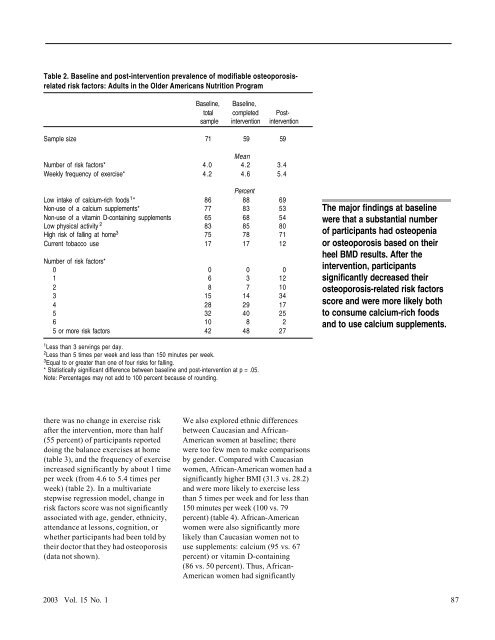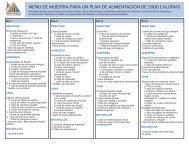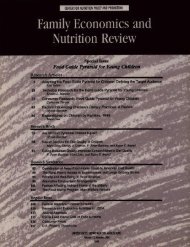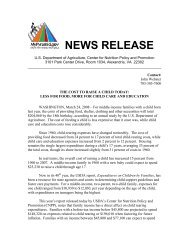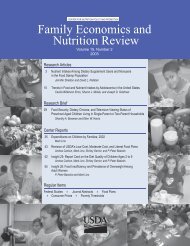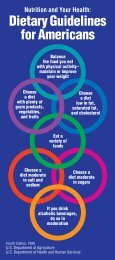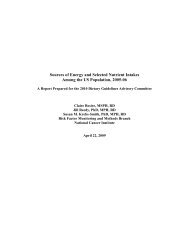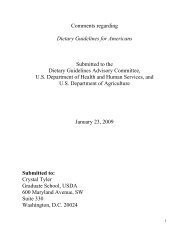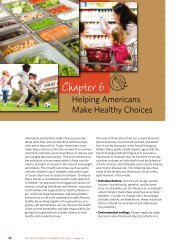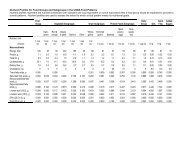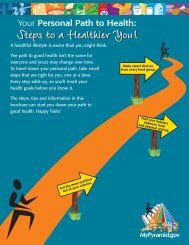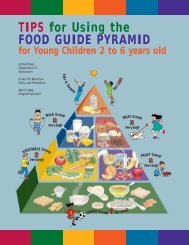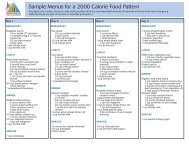Elderly Nutrition - Center for Nutrition Policy and Promotion - US ...
Elderly Nutrition - Center for Nutrition Policy and Promotion - US ...
Elderly Nutrition - Center for Nutrition Policy and Promotion - US ...
Create successful ePaper yourself
Turn your PDF publications into a flip-book with our unique Google optimized e-Paper software.
Table 2. Baseline <strong>and</strong> post-intervention prevalence of modifiable osteoporosisrelated<br />
risk factors: Adults in the Older Americans <strong>Nutrition</strong> Program<br />
Baseline, Baseline,<br />
total completed Postsample<br />
intervention intervention<br />
Sample size 71 59 59<br />
Mean<br />
Number of risk factors* 4.0 4.2 3.4<br />
Weekly frequency of exercise* 4.2 4.6 5.4<br />
Percent<br />
Low intake of calcium-rich foods 1 * 86 88 69<br />
Non-use of a calcium supplements* 77 83 53<br />
Non-use of a vitamin D-containing supplements 65 68 54<br />
Low physical activity 2 83 85 80<br />
High risk of falling at home 3 75 78 71<br />
Current tobacco use 17 17 12<br />
Number of risk factors*<br />
0 0 0 0<br />
1 6 3 12<br />
2 8 7 10<br />
3 15 14 34<br />
4 28 29 17<br />
5 32 40 25<br />
6 10 8 2<br />
5 or more risk factors 42 48 27<br />
The major findings at baseline<br />
were that a substantial number<br />
of participants had osteopenia<br />
or osteoporosis based on their<br />
heel BMD results. After the<br />
intervention, participants<br />
significantly decreased their<br />
osteoporosis-related risk factors<br />
score <strong>and</strong> were more likely both<br />
to consume calcium-rich foods<br />
<strong>and</strong> to use calcium supplements.<br />
1 Less than 3 servings per day.<br />
2 Less than 5 times per week <strong>and</strong> less than 150 minutes per week.<br />
3 Equal to or greater than one of four risks <strong>for</strong> falling.<br />
* Statistically significant difference between baseline <strong>and</strong> post-intervention at p = .05.<br />
Note: Percentages may not add to 100 percent because of rounding.<br />
there was no change in exercise risk<br />
after the intervention, more than half<br />
(55 percent) of participants reported<br />
doing the balance exercises at home<br />
(table 3), <strong>and</strong> the frequency of exercise<br />
increased significantly by about 1 time<br />
per week (from 4.6 to 5.4 times per<br />
week) (table 2). In a multivariate<br />
stepwise regression model, change in<br />
risk factors score was not significantly<br />
associated with age, gender, ethnicity,<br />
attendance at lessons, cognition, or<br />
whether participants had been told by<br />
their doctor that they had osteoporosis<br />
(data not shown).<br />
We also explored ethnic differences<br />
between Caucasian <strong>and</strong> African-<br />
American women at baseline; there<br />
were too few men to make comparisons<br />
by gender. Compared with Caucasian<br />
women, African-American women had a<br />
significantly higher BMI (31.3 vs. 28.2)<br />
<strong>and</strong> were more likely to exercise less<br />
than 5 times per week <strong>and</strong> <strong>for</strong> less than<br />
150 minutes per week (100 vs. 79<br />
percent) (table 4). African-American<br />
women were also significantly more<br />
likely than Caucasian women not to<br />
use supplements: calcium (95 vs. 67<br />
percent) or vitamin D-containing<br />
(86 vs. 50 percent). Thus, African-<br />
American women had significantly<br />
2003 Vol. 15 No. 1 87


